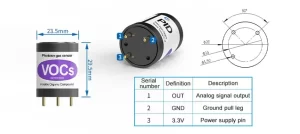Gas sensors are essential devices that play a crucial role in detecting and measuring various toxic gases present in our environment. These sensors are designed to provide accurate and real-time information about the concentration of harmful gases, allowing us to take necessary precautions to protect ourselves and the environment.

There are numerous toxic gases that gas sensors can detect, but in this article, we will mainly focus on some of the most common ones.
One of the primary gases that gas sensors can detect is carbon monoxide (CO).
Carbon monoxide is a colorless and odorless gas that is produced from the incomplete combustion of fuels such as gasoline, wood, coal, and natural gas. It is highly toxic and can cause serious health issues or even death if exposed to high concentrations. Gas sensors equipped with carbon monoxide detectors are widely used in homes, factories, and vehicles to ensure the safety of individuals.
Another toxic gas that gas sensors can detect is hydrogen sulfide (H2S)
Hydrogen sulfide is a poisonous gas that is produced naturally from the decomposition of organic materials containing sulfur. It has a distinct odor resembling rotten eggs, but at higher concentrations, it can paralyze the olfactory system, making it impossible to detect. Gas sensors equipped with hydrogen sulfide detectors are commonly used in industries such as oil refineries, wastewater treatment plants, and chemical manufacturing facilities to protect workers from exposure.
Ammonia (NH3) is another common toxic gas that gas sensors can detect
Ammonia is a colorless gas with a strong and pungent odor. It is commonly used in the production of fertilizers, cleaning products, and refrigeration systems. However, at high concentrations, ammonia can cause severe irritation to the respiratory system and can be fatal. Gas sensors equipped with ammonia detectors are utilized in industries where ammonia is used or produced to ensure the safety of workers and the surrounding environment.
Sulfur dioxide (SO2) is a toxic gas that gas sensors can also detect
Sulfur dioxide is produced from the burning of fossil fuels containing sulfur, such as coal and oil. It is a major air pollutant and can cause respiratory issues, particularly in individuals with asthma or other respiratory conditions. Gas sensors equipped with sulfur dioxide detectors are commonly used in industrial areas, power plants, and areas with high traffic to monitor air quality and alert authorities when the concentration exceeds safe levels.
Apart from the gases mentioned above
gas sensors can also detect other toxic gases such as ozone (O3), nitrogen dioxide (NO2), chlorine (Cl2), and many more. These gases are produced from various industrial processes, combustion of fuels, and chemical reactions. Gas sensors equipped with multiple detectors can provide comprehensive monitoring of these gases, ensuring the safety of individuals and the environment.

In conclusion
gas sensors are vital devices that play a crucial role in detecting and measuring toxic gases in our environment. They can detect gases such as carbon monoxide, hydrogen sulfide, ammonia, sulfur dioxide, ozone, nitrogen dioxide, chlorine, and many more. By providing accurate and real-time information, gas sensors enable us to take necessary precautions to protect ourselves and the environment from the harmful effects of these gases.
 : +86 155 8830 2704
: +86 155 8830 2704 : jxdziot@gmail.com
: jxdziot@gmail.com
